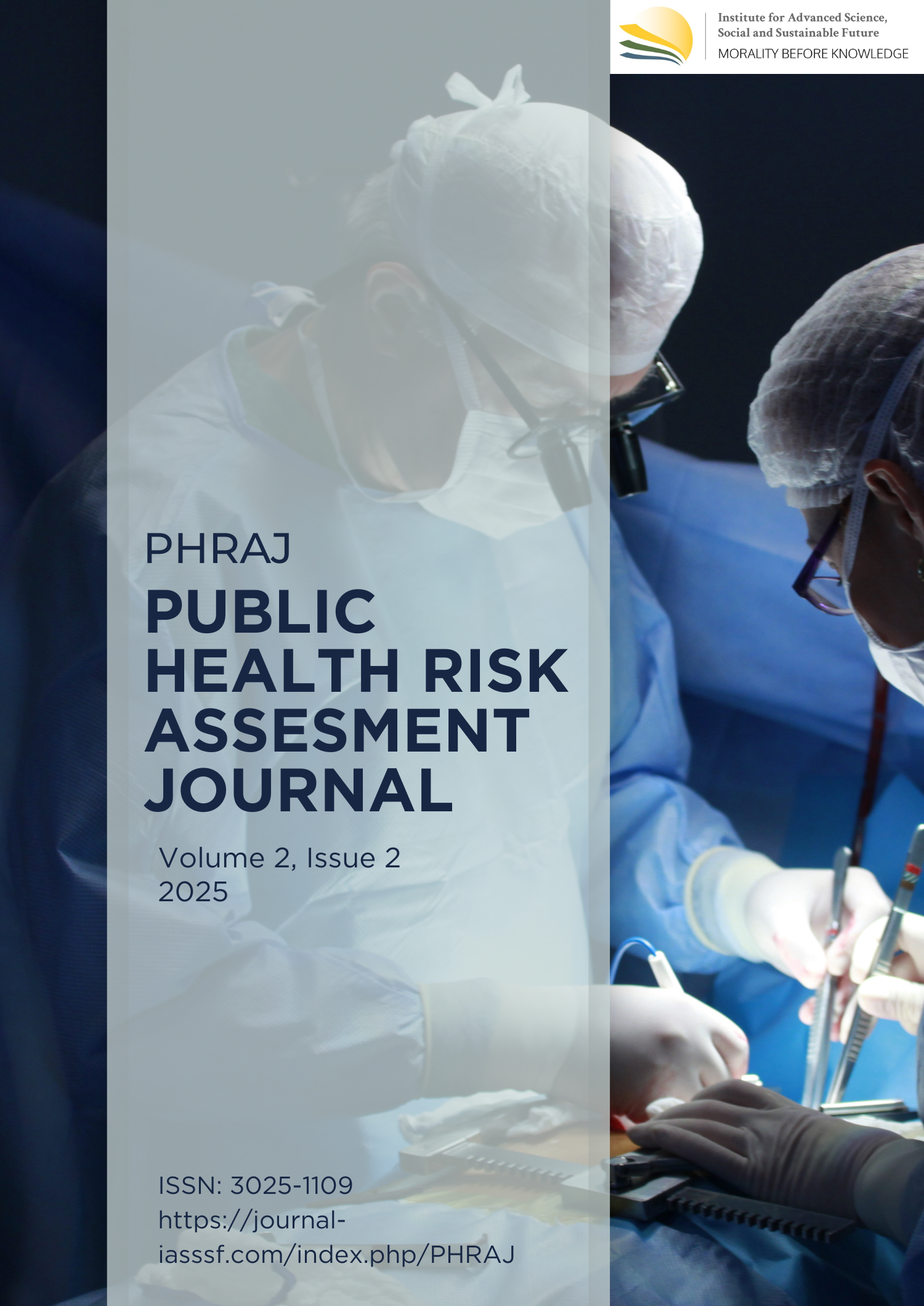Quality of life of children with HIV/AIDS in meeting their developmental stages based on WHOQOL-100
DOI:
https://doi.org/10.61511/phraj.v2i2.2025.1261Keywords:
children, HIV/AIDS, quality of life, life span, WHOQOL-100Abstract
Background: The number of HIV/AIDS children in Indonesia is rising, impacting their low quality of life. World Health Organization Quality of Life-100 (WHOQOL-100) is necessary to assess their life perceptions. Improving their quality of life requires a lifespan perspective to understand their development. This study aims to describe HIV/AIDS children's quality of life using WHOQOL- 100 and how it aligns with their developmental stages. Methods: This study employs a literature review method, as defined by Knopf (2006), to synthesize existing research on the quality of life of children with HIV/AIDS. It follows Neuman’s (2014) process of identifying, filtering, and analyzing relevant studies using WHOQOL-100 as a framework. The review focuses on journals from 2014-2024, selecting studies that involve children under 21, to draw broad conclusions and identify gaps in research. Findings: The findings reveal that children with HIV/AIDS have issues such as pain, poor nutrition, sleep problems, cognitive issues, low self-esteem, and caregiver burden. Early ART treatment, strategies against social stigma, good financial management, adequate healthcare access, and spiritual support are crucial for the children with HIV/AIDS. Inadequate caregiving, financial oversight, mismatched spiritual support, social stigma, and health issues hinder their development. Conclusion: Social support from caregivers and government health services play a crucial role in improving the quality of life for children with HIV/AIDS. However, not all children meet their developmental stages, highlighting the need for caregiver support, peer interactions, and consistent health services. Novelty/Originality of this Study: This study offers a unique perspective on the quality of life of HIV/AIDS-affected children in Indonesia by utilizing the WHOQOL-100 to explore how developmental stages influence their well-being, highlighting the importance of early treatment, caregiver support, and addressing social stigma in enhancing their quality of life.
References
Adefalu, M. O., Tunde-Ayinmode, M. F., Issa, B. A., Adefalu, A. A., & Adepoju, S. A. (2018). Psychiatric morbidity in children with HIV/AIDS at a tertiary health institution in North- central Nigeria. Journal of Tropical Pediatrics, 64(1), 38–44. https://doi.org/10.1093/tropej/fmx025.
Adi, I. R. (2013). Perencanaan partisipatoris berbasis aset komunitas: Dari pemikiran menuju penerapan. Fisip UI Press.
Adnyana, I. G. A. N. S., Gunardi, H., & Kurniati, N. (2019). Quality of Life of Children With HIV Infection. International Journal of Clinical Pediatrics and Child Health, 1(1), 1–8. https://journal.iipch.org/ijcpch/article/view/16
Barsky, A. E. (2010). Ethics and values in social work: An integrated approach for a comprehensive curriculum. Journal of Baccalaureate Social Work, 24(1). 261–264. https://doi.org/10.18084/1084-7219.24.1.261
Centers for Disease Control and Precention (CDC). (2024). About HIV. https://www.cdc.gov/hiv/about/index.html.
Cohen, S., ter Stege, J. A., Weijsenfeld, A. M., van der Plas, A., Kuijpers, T. W., Reiss, P., Scherpbier, H. J., Haverman, L., & Pajkrt, D. (2015). Health-related quality of life in perinatally HIV-infected children in the Netherlands. AIDS Care, 27(10), 1279–1288.
https://doi.org/10.1080/09540121.2015.1050986
Gehlert, S., & Browne, T. A. (2012). Handbook of health social work. John Wiley & Sons, Inc.
Gerring, J. (2004). What is a case study and what is it good for? American Political Science Review, 98(2), 341–354. https://doi.org/10.1017/S0003055404001182
Hartanti, A. (2017). Caregiver behavior in ARV treatment in children with HIV/AIDS. Journal of Midwifery, 9(1), 43-58. https://doi.org/10.35872/jurkeb.v9i01.307
Knopf, J. W. (2006). Doing a literature review. PS - Political Science and Politics, 39(1), 127– 132. https://doi.org/10.1017/S10490965606026
Lang, T., Heylen, E., Perumpil, S., Shet, A., Perumpil, M., Steward, W., Shamban, E., & Ekstrand, M. L. (2014). Quality of life and psychosocial well-being among children living with HIV at a care home in Southern India. Vulnerable Children and Youth Studies, 9(4), 345–352. https://doi.org/10.1080/17450128.2014.933942
Latipah, S., & Milanda, C. (2021). Hubungan stigma sosial dan kualitas hidup pada anak dengan HIV/AIDS di Yayasan VSE Jakarta Barat. Journal Center of Research Publication in Midwifery and Nursing, 5(2), 31–39. https://doi.org/10.36474/caring.v5i2.201
Ministry of Health of the Republic of Indonesia (Kemenkes RI). (2019). Program guidelines for prevention of mother-to-child transmission of HIV, Syphilis & Hepatitis B, 8(5). Ministry of Health RI.
Muhaimin, T., Utomo, B., Utoyo, D. B., Kurniati, N., Anugrahini, T., Utami, F. R., & Zuliatie, E. (2011). Quality of life measurement instrument for HIV-infected children. Public Health: National Public Health Journal, 6(3), 126–132. https://doi.org/10.21109/kesmas.v6i3.103
Muharman, & Jendrius, I. (2019). Social practices of parenting children infected with HIV and AIDS in families in Padang City: A study of six families with HIV/AIDS infected children. FOKUS Journal of Islamic and Social Studies, 4(2), 173–193). https://doi.org/10.29240/jf.v4i2.1042
Neuman, W. L. (2014). Social research methods: Qualitative and quantitative approaches (7th ed). Pearson Education Limited.
Nkwata, A. K., Zalwango, S. K., Kizza, F. N., Sekandi, J. N., Mutanga, J., Zhang, M., Musoke, P. M., & Ezeamama, A. E. (2017). Quality of life among perinatally HIV-affected and HIV-unaffected school-aged and adolescent Ugandan children: a multi-dimensional assessment of wellbeing in the post-HAART era. Quality of Life Research, 26(9), 2397– 2408. https://doi.org/10.1007/s11136-017-1597-2
Ogbonna-Nwosu, C. G., Iloh, K. K., Onu, J. U., Nwosu, I. F., Ibeziako, N., Onyire, N., Obu, D. C., Nwosu, C. A., Ezeudemba, N. C., & Ifejika, C. U. (2022). Health-related quality of life among HIV-infected children and its association with socio-demographic, clinical and nutritional variables: A comparative approach. Cureus, 14(5), https://doi.org/10.7759/cureus.25222
Perez, M. A., & Luquis, R. R. (2008). Cultural competence in health education and health promotion. Jossey-Bass
Perumbil Pathrose, S., Washington, R. G., Washington, M., Raj, M., Sreenath K, Sudhesh N T, He, S., & Ramjan, L. (2023). Quality of life of children and adolescents living with HIV in India: a systematic review and meta-analysis. Vulnerable Children and Youth Studies, 19(1), 103–123. https://doi.org/10.1080/17450128.2023.2254550
Pramadhani, W., & Allenidekania. (2022). Efektifvitas pemberian dukungan pada remaja ODHA terhadap dampak Kualitas hidup: Systematic review. Jurnal Endurance, 7(2), 396–407. https://doi.org/10.22216/jen.v7i2.1046
Pratiwi, A. D., Windi, R. R., & Berawi, K. N. (2023). Acquired Immunodeficiency Syndrome di RSUD Abdul Moeloek Provinsi Lampung. Medula, 13(4), 600–608. https://doi.org/10.53089/medula.v13i4.665
Putera, A. M., Irwanto., & Maramis, M. M. (2020). Quality-of-Life (QoL) of Indonesian children living with HIV: The role of caregiver stigma, burden of care, and coping. HIV/AIDS (Auckland, N.Z), 12, 573–581. https://doi.org/10.2147/HIV.S269629
Rydström, L.-L., Wiklander, M., Navér, L., Ygge, B.-M., & Eriksson, L. E. (2016). HIV-related stigma and health-related quality of life among children living with HIV in Sweden. AIDS Care, 28(5), 665–671. https://doi.org/10.1080/09540121.2015.1120267
Santrock, J. (2012). Life-span development (13th ed). McGraw-Hill.
Srinatania, D., & Karlina, R. C. (2021). Life experiences of adolescents with HIV/AIDS in Bandung City. Risenology, 6 (1a), 43–58. https://doi.org/10.47028/j.risenologi.2021.61a.213
Susilowati, I. (1999). Convention on the Rights of the Child. United Nations Children's Fund (UNICEF)
Swastika, Y. A. A., & Masykur, A. M. (2017). “Tabah until the end” A case study on families with HIV/AIDS. EMPATI Journal, 6(4), 424–432. https://doi.org/10.14710/empati.2017.20114
UNAIDS. (2023). UNAIDS data 2023. UNAIDS. http://www.unaids.org/es
World Health Organization. (2012). Programme on mental health: WHOQOL user manual.
Yumi, A. P.M., & Umma, Husnia Auliyatul Andarini, I. (2018). The correlation between Antiretroviral Therapy adherence and quality of life in children with HIV/AIDS at Dr. Moewardi General Hospital Surakarta Indonesia. Archives of Anesthesiology and Critical Care, 4(4), 527–534. http://www.globalbuddhism.org/jgb/index.php/jgb/article/view/88/100
Zielinska-Wieniawska, A., Bielecki, M., Wolanczyk, T., Kruk, M., Marczynska, M., Srebnicki, T., & Brynska, A. (2020). Health-related quality of life in Polish children and adolescents with perinatal HIV infection – short report. AIDS Care, 32(11), 1393–1399. https://doi.org/10.1080/09540121.2019.1699641
Downloads
Published
How to Cite
Issue
Section
Citation Check
License
Copyright (c) 2025 Armadini Caesar Ika Jati, Johanna Debora Imelda

This work is licensed under a Creative Commons Attribution 4.0 International License.















